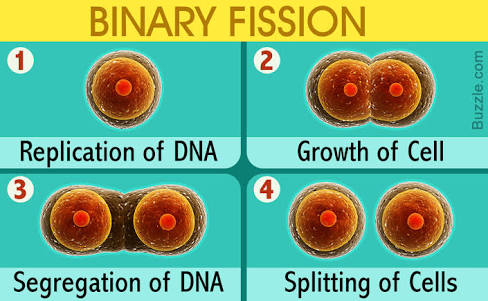Replication of deoxyribonucleic acid DNA marks the initiation of the binary fission process. A growing new cell wall begins to separate the bacterium.

Nuclear Fission The Stages Of Fission Britannica
Before binary fission of a prokaryote as seen in step 1 of the above graphic a prokaryote s DNA is tightly wound.

. The fission may be binary fission in which a single organism produces two. After copying the chromosome the bacterium starts to grow larger in preparation for binary fissions. Binding energy is related to how stable certain nuclei are with the largest being seemingly the most unstable the following graph shows which nucleons are best suited for fission or fusion.
Fission occurs when an atom is split. The range of fission fragments in air is only a few centimetres. The nucleus splits in two and releases thermal energy and more neutrons.
Nuclear energy is a result of the heat that is released during nuclear fission. In nuclear fission an unstable atom splits into two or more atoms of smaller sizes. Step 2- Growth of a Cell.
NCERT DC Pandey Sunil. Then the nucleus divides itself into two smaller nuclei. The step-by-step process of binary fission is enlisted below.
During the slowing-down process the charged atom picks up electrons from the medium and becomes neutral by the time it stops. The arrangement of particles within uranium-235 is somewhat unstable and the nucleus can disintegrate if it is excited by an outside source. Is the splitting of a large atomic nucleus into smaller nuclei.
What are the steps that occur in a nuclear fission. Sometimes the prokaryote will carry small plasmids which are small rings of DNA that carry extra genetic information. Each time one of these atoms splits or fissions more neutrons are released to split more atoms creating a chain reaction.
The complete development of the cell wall results in the split of the bacterium. The process of replicating nucleic acid begins from a replication origin. During this process one to three neutrons together with a binding energy are released.
The actual mass of a nucleus is always less than the sum of the masses of the free neutrons and protons that. To generate heat inside the reactor the operators introduce extra neutrons which cause the uranium atoms to split into smaller atoms. Nuclear fission is the process that occurs when the nucleus of an atom is split into two nuclei.
3 The fission of U-236 releases energy in the form of heat which is used to produce high pressure steam and ultimately electricity. During the second step of binary fission the DNA is unraveled. Describe the various steps involved in the process of binary fission with the help of a diagram.
Copying of DNA by replication enzymes begins at a spot on the chromosome called the origin of replication. The steps involved in the binary fission in bacteria are. Extra neutrons are released after every fission occurs which can trigger another fission and thus form a chain reaction that results in a huge amount of energy.
When a U-235 nucleus absorbs an extra neutron it quickly breaks into two parts. The Fission Process Fission involves the process of a large nuclei splitting into smaller nuclei either through a nuclear reaction of radioactive decay. As replication continues the two origins movetowards opposite ends of the cell pulling the rest of the chromosome along with them.
How is this reaction useful as the basis for the production of electrical energy. The origin is the firstpart of the DNA to be copied. In the nucleus of each atom of uranium-235 U-235 are 92 protons and 143 neutrons for a total of 235.
At this stage in the sequence of events the atom produced is called a fission product to distinguish it from the initial fission fragment formed at scission. Nuclear fission begins when a neutron hits the nucleus of an atom. These smaller pieces are more stable and release energy.
DNA is pulled to separate poles of the bacterium. Describe the process of fissionb. Steps of binary fission.
The daughter cells have tightly coiled DNA rods ribosomes and. First a uranium-235 absorbs a neutron. Nuclei consist of nucleons neutrons and protons the total number of which is equal to the mass number of the nucleus.
Following this a replication bubble is formed which separates the DNA strands. The missing mass has been converted into nuclear energy. The fission process may be best understood through a consideration of the structure and stability of nuclear matter.
Get solutions Get solutions Get solutions done loading Looking for the textbook. 4 The fission of U-236 releases two or three additional neutrons which can be used to cause other fissions and establish a chain reaction. Step 1- Replication of DNA.
Describe the steps that occur in the process of fission. Fission in biology is the division of a single entity into two or more parts and the regeneration of those parts to separate entities resembling the original. The bacterium uncoils and replicates its chromosome essentially doubling its content.
Describe the various steps involved in the process of binary fission with the help of a diagram. See answer 1 Best Answer. The neutrons hit the nuclei of more atoms splitting.
In a nuclear reactor a neutron is absorbed into a nucleus typically uranium-235. The steps involved in binary fission bacterial are -DNA of bacterium uncoils and duplicates. The object experiencing fission is usually a cell but the term may also refer to how organisms bodies populations or species split into discrete parts.
Solutions for Chapter 9 Problem 71QP. The resulting pieces have less combined mass. Binary fission steps.
However there are some methods to stop.

The Fission Process Mit Nuclear Reactor Laboratory

Bacterial Binary Fission The Cell Cycle And Mitosis Article Khan Academy Cell Cycle Mitosis Biology

Fission Vs Fusion What S The Difference Duke Energy Nuclear Information Center

0 Comments